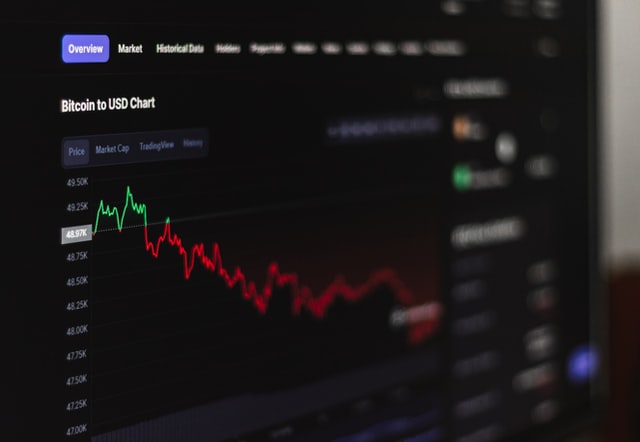
- (This article first appeared as a Youtube video. Watch it here)
Ever since the 5th of January, when the Federal Reserve released the minutes of its December meeting, Bitcoin and other cryptocurrencies have been on a free fall. Immediately after the Fed report was released, Bitcoin fell to slightly below $40,000, and Ethereum came terribly close to the $3000 mark. They have since gained about $2000 and $200 respectively but the values are still incredibly low compared to their most recent highs. So the question is, what was in this report that scared investors so much? And why is bitcoin crashing despite the ever-rising inflation numbers?
In This Article
Inflation at a 30-year high
In December, we learned that inflation had risen to its highest level in more than 30 years. As a result, when the Federal Reserve met on the 14th and 15th of December, investors expected them to take all reasonable steps to combat increasing inflation.
Read More: What is Inflation (How to Profit from Inflation)
What investors didn’t expect, however, was the Federal Reserve’s announcement that inflation would persist much longer than expected and that they would use even more aggressive measures to tackle it.
So, now that the Fed has stated that inflation will persist for some time, the burning question is: why is bitcoin crashing? Isn’t bitcoin meant to be a hedge against inflation?
Here are three reasons why:
1. Rising interest rates make safer assets more lucrative to investors

To understand how rising interest rates affect bitcoin, we must first grasp how rising interest rates affect treasury bonds. I know bonds are unexciting, but they have a significant impact on the larger market, so please bear with me for a bit.
The government uses treasury bonds to borrow money from individuals and organizations. In exchange, the government pays a market interest rate (often known as bond yield).
You could, for example, lend the government $10,000 by purchasing a 10-year treasury bond. The government then agrees to pay you an annual interest rate of 1.7 percent for the next ten years. This implies you’ll get a $170 bond coupon each year. It may seem like a small amount, but when large organizations purchase bonds worth billions of dollars, the profits pile up quickly.
Read More: How to Prepare for a Stock Market Crash In 2022
What makes treasury bonds special is that they are some of the safest investment assets out there. When it comes to investment safety, it doesn’t get any safer than lending money to the government of the United States – one of the most stable economies in the world – and getting paid interest for several years before getting your money back once the lending period has ended, for example, ten years (also known as bond maturity).
So when the Fed raises interest rates, the interest paid on treasury bonds also rises, which means you get more interest on the same amount of money loaned to the government. And so, treasury bonds become more attractive than other investments for two reasons:
- they now offer better returns
- They guarantee safety, unlike investments such as bitcoin, which are extremely risky and could lose more than 50% of their value in a few days.
At this point, Investors ask themselves a simple question: would I rather put my money in a safe investment that guarantees a higher interest, or do I put my money in a risky asset which nobody knows whether it will perform well in this economy. This is when investors begin to trade their high-risk crypto for safer options like treasury bonds, and bitcoin starts to slowly fall.

2. Tougher Contractionary measures by the Fed
The second reason why Bitcoin is crashing is the strict contractionary measures that the Fed announced in its report last Wednesday.
Indeed, there is high inflation, which is expected to last a long time. And we know bitcoin should thrive during inflationary periods. But why is it crashing instead?
The other possible reason is the Fed’s announcement that it will be taking more rigorous contractionary measures to correct inflation.
So instead of continuing to print money (which raises inflation and makes bitcoin go up), the Fed announced that it would end its bond purchasing program sooner and start raising interest rates by March this year.
If that’s not contractionary enough, the Fed also plans to start selling the assets on its balance sheet shortly after the bond-purchasing program ends.
But what does it mean by “the Fed selling its assets,” and why is it an aggressive measure?
This might sound a bit complicated, but I’ll try to break it down further.
Read More: 3 Financial Trends To Avoid in 2022
Let’s roll back a bit to when the pandemic hit in 2020. There were fears that the economy would slow down, shrinking the GDP and causing massive job losses, just like what happened during the depression of 1929. So in response, the government passed policies that would provide stimulus relief to individuals and distressed businesses. Additionally, the Federal Reserve also took its own monetary stimulus measures. We’ve all heard the infamous statement, “the Fed is printing and pumping money into the economy,” but how do they do it?
When the Fed “prints money and pumps it into the economy,” they do it by buying assets such as bonds and mortgage-backed securities from banks, institutions, and distressed companies. This way, they lend money to them and make cash readily available to businesses so that they don’t go bankrupt.
Meanwhile, the more the Fed buys these assets, the more its balance sheet grows, and right now, it has about $8.7 trillion in its balance sheet. So the Fed is now planning to sell these assets.
Now, it’s normal for the Fed to sell the assets on its balance sheet. What makes this a harsh contractionary measure is the fact that the Fed will be selling them shortly after the bond-buying program ends. In the past, the Fed has waited about two years after a monetary stimulus ends before it starts offloading its bonds.
But, what’s the problem with the Fed selling its assets?
An increased supply of treasury bonds in the market will push prices downwards, causing bond yields to rise and result in what we discussed in the first point: make safe investments like treasury bonds more attractive to investors by offering them even better interest rates.
I hope I didn’t lose you there.
Here’s a more straightforward explanation, when the Fed floods the market with bonds, the following will happen
- The price of bonds will fall
- Bond yields will consequently rise
- Attract more investors
- Investors will dump risky assets and buy bonds
3. A Strengthening Dollar

Data collected over the period Bitcoin has been around shows that sometimes, the value of Bitcoin is inversely proportional to a strengthening dollar, which means that when the value of the dollar goes up, the value of Bitcoin goes down. Of course, this is not always the case, but it has happened many times.
And remember the two actions the Fed will be taking to reduce inflation? i.e
- Increasing interest rates and
- Selling off assets on its balance sheet?
These two actions actually strengthen the dollar. As a result, the dollar becomes a haven for investors worldwide, especially those from countries with weaker currencies who prefer to park their money in a high-yielding currency that guarantees their returns and protects the value of their money more than a high-risk asset like Bitcoin would.
Conclusion
So the main reason Bitcoin is falling is due to the interest rate hikes expected in March.
The other reason is that investors are waiting for the price of bonds to severely drop when the Fed starts selling their treasury bonds.
And finally, a strengthening dollar is not always a good thing for bitcoin.

















